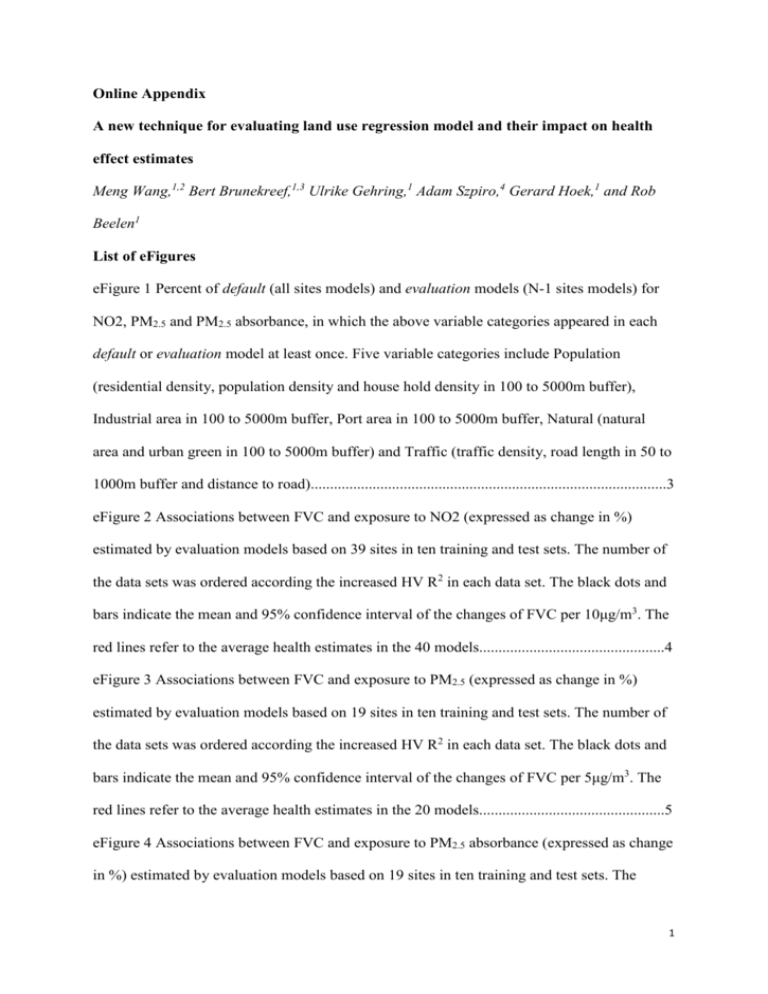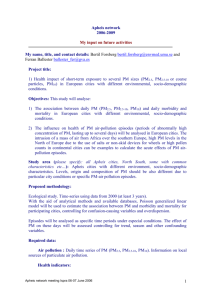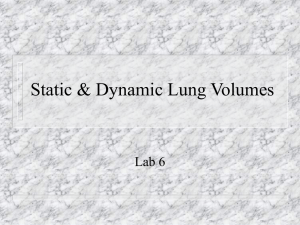eFigure 3 Associations between FVC and exposure to PM 2.5
advertisement

Online Appendix A new technique for evaluating land use regression model and their impact on health effect estimates Meng Wang,1,2 Bert Brunekreef,1,3 Ulrike Gehring,1 Adam Szpiro,4 Gerard Hoek,1 and Rob Beelen1 List of eFigures eFigure 1 Percent of default (all sites models) and evaluation models (N-1 sites models) for NO2, PM2.5 and PM2.5 absorbance, in which the above variable categories appeared in each default or evaluation model at least once. Five variable categories include Population (residential density, population density and house hold density in 100 to 5000m buffer), Industrial area in 100 to 5000m buffer, Port area in 100 to 5000m buffer, Natural (natural area and urban green in 100 to 5000m buffer) and Traffic (traffic density, road length in 50 to 1000m buffer and distance to road)............................................................................................3 eFigure 2 Associations between FVC and exposure to NO2 (expressed as change in %) estimated by evaluation models based on 39 sites in ten training and test sets. The number of the data sets was ordered according the increased HV R2 in each data set. The black dots and bars indicate the mean and 95% confidence interval of the changes of FVC per 10μg/m3. The red lines refer to the average health estimates in the 40 models................................................4 eFigure 3 Associations between FVC and exposure to PM2.5 (expressed as change in %) estimated by evaluation models based on 19 sites in ten training and test sets. The number of the data sets was ordered according the increased HV R2 in each data set. The black dots and bars indicate the mean and 95% confidence interval of the changes of FVC per 5μg/m3. The red lines refer to the average health estimates in the 20 models................................................5 eFigure 4 Associations between FVC and exposure to PM2.5 absorbance (expressed as change in %) estimated by evaluation models based on 19 sites in ten training and test sets. The 1 number of the data sets was ordered according the increased HV R2 in each data set. The black dots and bars indicate the mean and 95% confidence interval of the changes of FVC per 1 unit/m3. The red lines refer to the average health estimates in the 20 models. .....................6 List of eTables eTable 1 List of predictor variables for model development, buffer sizes and a priori defined direction of effect......................................................................................................................7 eTable 2 Statistical descriptive of Pearson correlation coefficients between evaluation model predictions for PM2.5, PM2.5 absorbance and NO2, and the significance analyzed by ANOVA. ................................................................................................................................. 8 2 eFigure 1 Percent of default (all sites models) and evaluation models (N-1 sites models) for NO2, PM2.5 and PM2.5 absorbance, in which the above variable categories appeared in each default or evaluation model at least once. Five variable categories include Population (residential density, population density and house hold density in 100 to 5000m buffer), Industrial area in 100 to 5000m buffer, Port area in 100 to 5000m buffer, Natural (natural area and urban green in 100 to 5000m buffer) and Traffic (traffic density, road length in 50 to 1000m buffer and distance to road). 3 eFigure 2 Associations between FVC and exposure to NO2 (expressed as change in %) estimated by evaluation models based on 39 sites in ten training and test sets. The number of the data sets was ordered according the increased HV R2 in each data set. The black dots and bars indicate the mean and 95% confidence interval of the changes of FVC per 10μg/m3. The red lines refer to the average health estimates in the 40 models. 4 eFigure 3 Associations between FVC and exposure to PM2.5 (expressed as change in %) estimated by evaluation models based on 19 sites in ten training and test sets. The number of the data sets was ordered according the increased HV R2 in each data set. The black dots and bars indicate the mean and 95% confidence interval of the changes of FVC per 5μg/m3. The red lines refer to the average health estimates in the 20 models. 5 eFigure 4 Associations between FVC and exposure to PM2.5 absorbance (expressed as change in %) estimated by evaluation models based on 19 sites in ten training and test sets. The number of the data sets was ordered according the increased HV R2 in each data set. The black dots and bars indicate the mean and 95% confidence interval of the changes of FVC per 1 unit/m3. The red lines refer to the average health estimates in the 20 models. 6 eTable 1 List of predictor variables for model development, buffer sizes and a priori defined direction of effect Variable Buffer size (m) Directio n High and low residential density 100, 300, 500, 1000, + 5000 Port 300, 500, 1000, 5000 + Industry 300, 500, 1000, 5000 + Urban green and natural areas 100, 300, 500, 1000, - 5000 Road length 50, 100, 300, 500, + 1000 Major road length 50, 100, 300, 500, 1000 Traffic intensity in the nearest road NA + (Squared) Inverse distance to the nearest road NA + (Squared) Invest distance to the nearest NA + Traffic intensity in the major road NA + (Squared) Inverse distance to the nearest major NA + NA + Total traffic load of roads in a buffer (sum of 50, 100, 300, 500, + (traffic intensity * length of all segments)) 1000 Total traffic load of major roads in a buffer 50, 100, 300, 500, (sum of (traffic intensity * length of all 1000 road*traffic intensity in the nearest road road (Squared) Invest distance to the major road *traffic intensity in the major road + segments)) Population 100, 300, 500, 1000, + 5000 Urban green 100, 300, 500, 1000, - 5000 NA: not applicable. 7 eTable 2 Statistical descriptive of Pearson correlation coefficients between evaluation model predictions for PM2.5, PM2.5 absorbance and NO2, and the significance analyzed by ANOVA. Pollutants Minimum Maximum Median p-value PM2.5 -0.27 0.99 0.75 <0.01 PM2.5 absorbance 0.36 0.99 0.94 >0.05 NO2 0.58 0.99 0.98 >0.05 8







